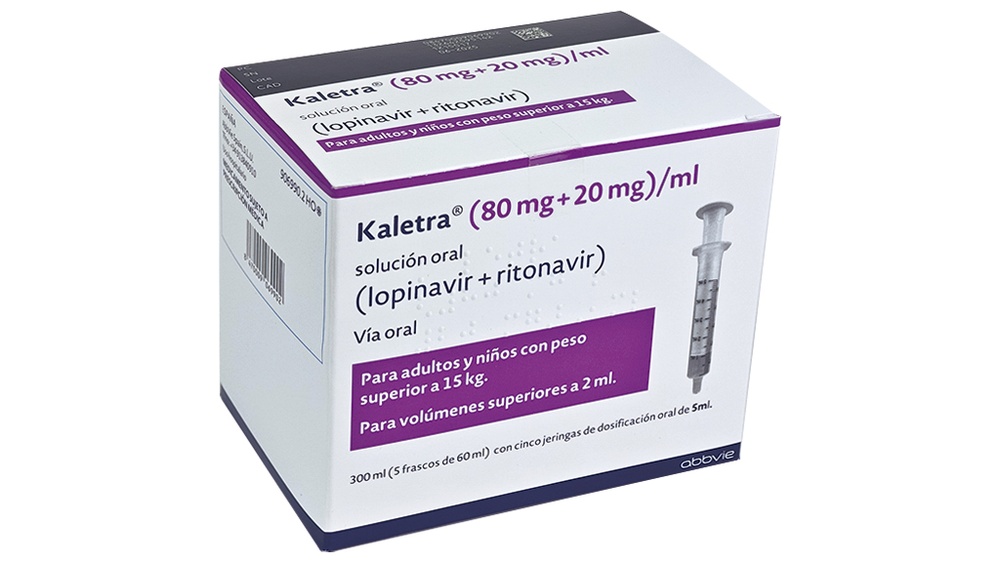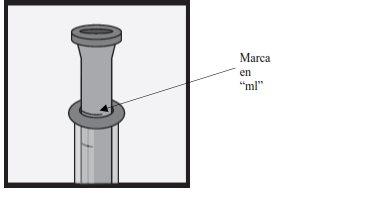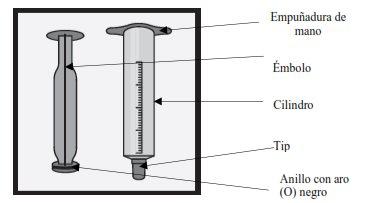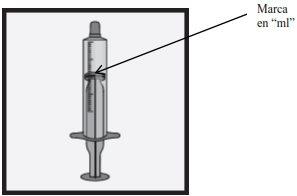

KALETRA (80 mg + 20 mg)/mL ORAL SOLUTION

Ask a doctor about a prescription for KALETRA (80 mg + 20 mg)/mL ORAL SOLUTION

How to use KALETRA (80 mg + 20 mg)/mL ORAL SOLUTION
Introduction
Package Leaflet: Information for the User
Kaletra (80 mg + 20 mg)/ml Oral Solution
(lopinavir + ritonavir)
Read all of this leaflet carefully before you start taking this medicine because it contains important information for you or your child.
- Keep this leaflet, you may need to read it again.
- If you have any further questions, ask your doctor or pharmacist.
- This medicine has been prescribed for you or your child only. Do not pass it on to others. It may harm them, even if their signs of illness are the same as yours.
- If you experience any side effects, talk to your doctor or pharmacist. This includes any possible side effects not listed in this leaflet. See section 4.
Contents of the pack
- What is Kaletra and what is it used for
- What you need to know before you or your child take Kaletra
- How to take Kaletra
- Possible side effects
- Storing Kaletra
- Contents of the pack and other information
1. What is Kaletra and what is it used for
- Your doctor has prescribed Kaletra to help control your human immunodeficiency virus (HIV) infection. This is possible because Kaletra works by preventing the infection from spreading quickly.
- Kaletra is not a cure for HIV infection or AIDS.
- Kaletra is used in children from 14 days of age and older, in adolescents and adults infected with HIV, the virus that causes AIDS.
- Kaletra contains the active substances lopinavir and ritonavir. Kaletra is an antiretroviral medicine that belongs to a group of medicines called protease inhibitors.
- Kaletra is prescribed for use in combination with other antiviral medicines. Your doctor will inform you and decide which medicines are best for your case.
2. What you need to know before you or your child take Kaletra
Do not take Kaletra:
- if you are allergic to lopinavir, ritonavir or any of the other ingredients of this medicine (listed in section 6).
- if you have severe liver problems.
Do not take Kaletra with any of the following medicines:
- astemizole or terfenadine (usually used to treat allergy symptoms – these medicines may not require a prescription);
- oral midazolam (taken by mouth), triazolam (used to relieve anxiety and/or sleep problems);
- pimozide (used to treat schizophrenia);
- quetiapine (used to treat schizophrenia, bipolar disorder and major depressive disorder);
- lurasidone (used to treat depression);
- ranolazine (used to treat chronic chest pain [angina pectoris]);
- cisapride (used to relieve certain stomach problems);
- ergotamine, dihydroergotamine, ergonovine and methylergonovine (used to treat headaches);
- amiodarone, dronedarone (used to treat heart rhythm disorders);
- lovastatin, simvastatin (used to lower blood cholesterol);
- lomitapide (used to lower blood cholesterol);
- alfuzosin (used in men to treat symptoms of enlarged prostate [benign prostatic hyperplasia (BPH)]);
- fusidic acid (used to treat skin infections caused by the bacteria Staphylococcus such as impetigo and infected dermatitis). Fusidic acid is also used to treat long-term bone and joint infections (e.g. osteomyelitis) under medical supervision (see Using Kaletra with other medicines);
- colchicine (medicine used to treat gout). If you have liver or kidney problems (see Other medicines and Kaletra);
- elbasvir/grazoprevir (used to treat chronic hepatitis C virus [HCV] infection);
- ombitasvir/paritaprevir/ritonavir with or without dasabuvir (used to treat chronic hepatitis C virus [HCV] infection);
- neratinib (used to treat breast cancer);
- avanafil or vardenafil (used to treat impotence);
- sildenafil used for the treatment of pulmonary hypertension (high blood pressure in the pulmonary artery). Sildenafil may be used for the treatment of erectile dysfunction under medical supervision (see Other medicines and Kaletra);
- products containing St. John's Wort (Hypericum perforatum).
For more information about other medicines that require special precautions see the list of medicines included below in“Other medicines and Kaletra”.
If you are currently taking any of these medicines, consult your doctor to see if you need to change your treatment for other conditions or your antiretroviral treatment.
Warnings and precautions
Consult your doctor or pharmacist before starting to take Kaletra.
Important information
- People taking Kaletra may still develop infections or other illnesses associated with HIV and AIDS. Therefore, it is essential that you remain under the supervision of your doctor while taking Kaletra.
- Even though effective antiretroviral treatment reduces the risk of transmission, while taking this medicine you can still transmit HIV to others. Consult your doctor about what precautions are necessary to avoid infecting others.
Tell your doctor if you or your child have or have had
- Hemophiliatype A and B, as Kaletra may increase the risk of bleeding.
- Diabetes, as increases in blood sugar have been reported in patients taking Kaletra.
- History of liver problems, as patients with a history of liver disease, including chronic hepatitis B or C, have a higher risk of severe and potentially life-threatening liver side effects.
Tell your doctor if you or your child are experiencing
- Nausea, vomiting, abdominal pain, difficulty breathing, and severe muscle weakness in the legs and arms, as these may be symptoms of increased lactic acid levels.
- Thirst, frequent urination, blurred vision, or weight loss, as this may indicate high blood sugar levels.
- Nausea, vomiting, abdominal pain, as significant increases in triglycerides (fats in the blood) are considered a risk factor for pancreatitis (inflammation of the pancreas) and the described symptoms may suggest this condition.
- In some patients with advanced HIV infection and a history of opportunistic infections, signs and symptoms of inflammation of previous infections may occur shortly after starting anti-HIV treatment. These symptoms are believed to be due to an improvement in the body's immune response, allowing it to fight infections that were present without apparent symptoms.
- In addition to opportunistic infections, you may also experience autoimmune disorders (a problem that occurs when the immune system attacks the body's healthy tissue) after starting treatment for your HIV infection. Autoimmune disorders may appear several months after starting treatment. If you notice any symptoms of infection or other symptoms such as muscle weakness, weakness starting in the hands and feet and moving up the trunk, palpitations, tremors, or hyperactivity, please inform your doctor immediately to seek necessary treatment.
- Stiffness in the joints, pain, and discomfort(especially in the hip, knee, and shoulder) and difficulty moving, as some patients taking these medicines may develop a bone disease called osteonecrosis (death of bone tissue caused by loss of blood supply to the bone). Among the many risk factors for developing this disease are the duration of combination antiretroviral treatment, the use of corticosteroids, alcohol consumption, severe immunosuppression, and high body mass index.
- Muscle pain, discomfort, or weakness, particularly in combination with these medicines. In rare cases, these muscle disorders have been severe.
- Symptoms of dizziness, dizziness sensation, fainting, or sensation of abnormal heartbeats. Kaletra may cause changes in heart rhythm and electrical activity of the heart. These changes can be seen on an ECG (electrocardiogram).
Other medicines and Kaletra
Tell your doctor or pharmacist if you or your child are taking, have recently taken, or might take any other medicines.
- antibiotics (e.g. rifampicin, rifabutin, clarithromycin);
- anticancer medicines (e.g. abemaciclib, afatinib, apalutamide, ceritinib, encorafenib, ibrutinib, venetoclax, most tyrosine kinase inhibitors such as dasatinib and nilotinib, and also vincristine and vinblastine);
- anticoagulants (e.g. warfarin, rivaroxaban, vorapaxar);
- antidepressants (e.g. trazodone, bupropion);
- antiepileptic medicines (e.g. carbamazepine, phenytoin, phenobarbital, lamotrigine, and valproate);
- medicines for treating fungal infections (e.g. ketoconazole, itraconazole, voriconazole);
- medicines for treating gout (e.g. colchicine). You must not take Kaletra with colchicine if you have liver or kidney problems (see also “Do not take Kaletra” above);
- medicines for treating tuberculosis (e.g. bedaquiline, delamanid);
- antiviral medicines used in the treatment of chronic hepatitis C virus (HCV) infection in adults (e.g. glecaprevir/pibrentasvir, simeprevir, and sofosbuvir/velpatasvir/voxilaprevir);
- medicines for erectile dysfunction (e.g. sildenafil and tadalafil);
- fusidic acid used in the long-term treatment of bone and joint infections (e.g. osteomyelitis);
- medicines for the heart, including:
- digoxin;
- calcium channel blockers (e.g. felodipine, nifedipine, nicardipino);
- medicines used to correct heart rhythm (e.g. bepridil, systemic lidocaine, quinidine);
- HIV CCR5 antagonist (e.g. maraviroc)
- HIV-1 integrase inhibitor (e.g. raltegravir)
- levothyroxine (used to treat thyroid problems);
- medicines used to lower blood cholesterol (e.g. atorvastatin, lovastatin, rosuvastatin, or simvastatin);
- medicines used to treat asthma and other lung-related problems, such as chronic obstructive pulmonary disease (COPD) (e.g. salmeterol);
- medicines used to treat pulmonary arterial hypertension (high blood pressure in the pulmonary artery) (e.g. bosentan, riociguat, sildenafil, tadalafil);
- medicines that affect the immune system (e.g. cyclosporine, sirolimus (rapamycin), tacrolimus);
- medicines used to help stop smoking (e.g. bupropion);
- analgesics (e.g. fentanyl);
- medicines similar to morphine (e.g. methadone);
- oral contraceptives or contraceptive patches to prevent pregnancy (see section “Contraceptives” below);
- protease inhibitors (e.g. fosamprenavir, indinavir, ritonavir, saquinavir, tipranavir);
- sedatives (e.g. injectable midazolam);
- steroids (e.g. budesonide, dexamethasone, fluticasone propionate, ethinylestradiol, triamcinolone);
- medicines that interact with alcohol (e.g. disulfiram).
For more information about other medicines that you must not take if you are taking Kaletra see the list of medicines included above in“Do not take Kaletra with any of the following medicines”.
Tell your doctor or pharmacist if you or your child are taking, have recently taken, or might take any other medicines, including those obtained without a prescription.
Medicines for erectile dysfunction (e.g. avanafil, vardenafil, sildenafil, and tadalafil)
- Do not take Kaletraif you are currently taking avanafil or vardenafil.
- You must not take Kaletra with sildenafil when used for the treatment of pulmonary hypertension (high blood pressure in the pulmonary artery) (see also the section above Do not take Kaletra).
- If you are taking sildenafil or tadalafil and Kaletra together, you may be at risk of adverse reactions such as decreased blood pressure, fainting, changes in vision, and an erection of the penis that lasts more than 4 hours. If the erection of the penis lasts more than 4 hours, you must go immediatelyto the doctor to avoid permanent damage to the penis. Your doctor can explain these symptoms to you.
Contraceptives
- If you are taking oral contraceptives or a contraceptive patch to prevent pregnancy, you should use an additional or different type of contraception (e.g. condom), as Kaletra may reduce the effectiveness of oral contraceptives and patches.
- Kaletra does not reduce the risk of transmitting HIV to others. You must use appropriate precautions (e.g. using a condom) to prevent the transmission of the disease through sexual contact.
Pregnancy and breastfeeding
- If you are pregnant or breastfeeding, think you may be pregnant, or are planning to have a baby, consult your doctor immediatelybefore using this medicine.
- If you are pregnant or breastfeeding, consult your doctor or pharmacist before taking this medicine because it contains propylene glycol and alcohol. Pregnant or breastfeeding women should not take Kaletra oral solution unless specifically recommended by their doctor.
- It is recommended that HIV-infected women do not breastfeed their babies because there is a possibility that the baby may be infected with HIV through breast milk.
Driving and using machines
No specific studies have been conducted to assess the effects of Kaletra on the ability to drive and use machines. Do not drive or use machines if you experience any side effects (e.g. nausea) that may affect your ability to do so safely. Consult your doctor.
Kaletra contains 42% v/v ethanol. The amount of alcohol in this medicine may affect your ability to drive or use machines and may affect your judgment and reaction times.
Important information about some of the ingredients of Kaletra
Kaletra contains 42% v/v alcohol and 15% propylene glycol p/v. Each ml of Kaletra oral solution contains 356.3 mg of alcohol and 152.7 mg of propylene glycol. Alcohol and propylene glycol are potentially harmful to those who suffer from liver disease, kidney disease, alcoholism, epilepsy, brain disease or damage, as well as to pregnant women and children. These may modify or increase the effects of other medicines.
At the recommended dose(s) for adults of this medicine, the estimated blood alcohol concentration is approximately 0.002 - 0.01 g/dL. This is similar to an adult who has consumed 4-22 ml of beer or 1-4 ml of wine.
Other medicines may also contain alcohol, and alcohol may be consumed in foods and beverages. The combined effects may lead to an increase in blood alcohol levels and increase the side effects of alcohol.
This medicine contains up to 0.8 g of fructose per dose when administered according to the recommended dose. This may not be suitable for hereditary fructose intolerance. Because there may be a possibility of undetected fructose intolerance, the medicine should be administered to infants and children only after consulting a doctor.
Kaletra contains glycerol, which is harmful in high doses. It may cause headache and gastrointestinal discomfort and diarrhea.
Kaletra contains hydrogenated polyoxyl 40 castor oil. At high doses, it may cause nausea, vomiting, colic, and severe diarrhea. It should not be administered in cases of intestinal obstruction.
Kaletra contains potassium as acesulfame potassium, which may be harmful to people with a low-potassium diet. High potassium levels in the blood may cause stomach discomfort and diarrhea.
Kaletra contains sodium as sodium saccharin, sodium chloride, and sodium citrate, which may be harmful to people with a low-sodium diet.
3. How to Take Kaletra
Kaletra is recommended for use in adults and children 14 days of age and older who are infected with HIV.
Be careful when administering to children. The dose should be less than 5 ml twice a day in children who weigh less than 40 kg.
If you or your child are able to swallow tablets, Kaletra is also available as 200 mg of lopinavir and 50 mg of ritonavir in coated tablets and as 100 mg of lopinavir and 25 mg of ritonavir in coated tablets.
Always take this medication exactly as your doctor has told you. Consult your doctor or pharmacist if you have any doubts about how to take your medication.
How and When to Take Kaletra
For Children 14 Days and Older and Weighing Up to 15 kg
- Your doctor will decide the appropriate dose based on the child's height and weight.
- It is essential that all doses of Kaletra oral solution be taken with food.
- Use the provided 2 ml oral dosing syringe to measure the dose.
For Children Weighing More Than 15 kg
- The doctor will decide the correct dose based on the child's height and weight.
- It is essential that all doses of Kaletra oral solution be taken with food.
- Use the provided 5 ml oral dosing syringe to measure the dose.
Use in Adults
- The usual dose in adults is 5 ml of oral solution twice a day, e.g., every 12 hours, in combination with other HIV medications. Your doctor will recommend the amount of Kaletra you should take.
- It is essential that all doses of Kaletra oral solution be taken with food.
- Use the provided 5 ml oral dosing syringe to measure the dose.
How Do I Measure the Correct Dose?
- If the dose is up to 2 ml – use the 2 ml oral dosing syringe to prepare a dose.
- If the dose is between 2 ml and 5 ml – use the 5 ml oral dosing syringe to prepare a dose.
Check with your pharmacist that you have the correct syringe size. If you are unsure about how to use the oral dosing syringe, consult your doctor, pharmacist, or nurse. They will tell you how to use the syringe correctly.
Do not shake the bottle – this is because air bubbles may form that will affect how well you can measure the dose.
Open the child-resistant cap by pressing it with the palm of your hand and turning it counterclockwise or in the direction of the arrow on the top of the cap. If you have trouble opening the bottle, consult your pharmacist.

Using the 2 ml Oral Dosing Syringe
The syringe has two main parts, a 'plunger' and a 'cylinder'. In this image, we have removed the plunger so you can see each part clearly. |
|
|
|
Replace the bottle cap after each dose. |
Using the 5 ml Oral Dosing Syringe for Doses Greater Than 2 ml
The syringe has two main parts, a 'plunger' and a 'cylinder'. In this image, we have removed the plunger so you can see each part clearly. |
|
|
|
|
Replace the bottle cap after each dose.
After administering each dose of Kaletra, separate the plunger from the syringe body. Wash the plunger and syringe with dish soap and warm water as soon as possible; you can soak them in soapy water for up to 15 minutes. Rinse the syringe and plunger with clean water.
Put the plunger back into the syringe and fill and empty it several times with tap water to rinse. Let the syringe dry completely before using it again.
Do not use the oral dosing syringes provided with Kaletra oral solution to administer any other medication that you or your child are taking.
If You or Your Child Take More Kaletra Than You Should
- If you realize you have taken more Kaletra than indicated, inform your doctor immediately.
- If you cannot contact your doctor, go to the hospital.
If You or Your Child Miss a Dose of Kaletra
- If you realize you have missed a dose within 6 hours of the usual time, take it as soon as possible and then continue with the normal dosing schedule, taking the next dose at the time it is due, as prescribed by your doctor.
- If more than 6 hours have passed since the usual dose time, do not take the missed dose. Take the next dose at the usual time. Do not take a double dose to make up for missed doses.
If You or Your Child Stop Taking Kaletra
- Do not stop taking or change your daily dose of Kaletra without first consulting your doctor.
- Kaletra must be taken twice a day to help control HIV, regardless of any improvement you feel.
- Taking Kaletra as recommended is the best way to delay the development of resistance to the medication.
- If an adverse reaction prevents you from taking Kaletra as indicated, tell your doctor promptly.
- Always have a sufficient supply of Kaletra so you do not run out of medication. When traveling or needing to be in the hospital, make sure you have enough until you can get more.
Continue taking this medication until your doctor tells you to stop.
4. Possible Side Effects
Like all medications, Kaletra can cause side effects, although not everyone will experience them. It is difficult to distinguish between side effects caused by Kaletra and those caused by other medications you are taking at the same time or those derived from complications of HIV infection.
During HIV treatment, there may be an increase in weight and levels of glucose and lipids in the blood. This may be partly related to the recovery of health and lifestyle, and in the case of blood lipids, sometimes to HIV medications themselves. Your doctor will monitor these changes.
The following side effects have been reported by patients taking this medication.You should inform your doctor promptly about these or any other symptoms. Consult your doctor if they persist or worsen.
Very Common:may affect more than 1 in 10 people:
- diarrhea;
- nausea;
- upper respiratory tract infection;
Common:may affect up to 1 in 10 people:
- pancreatitis;
- vomiting, abdominal distension, abdominal pain, flatulence, indigestion, decreased appetite, reflux from the stomach to the esophagus that can cause pain;
- Tell your doctor if you experience nausea, vomiting, or abdominal pain, as these can be symptoms of pancreatitis (inflammation of the pancreas).
- swelling or inflammation of the stomach, intestine, and colon;
- increased levels of cholesterol in the blood, increased levels of triglycerides (a type of fat) in the blood, high blood pressure;
- decreased ability of the body to metabolize sugar, such as diabetes mellitus, weight loss;
- low red blood cell count, low white blood cell count that is used to fight infections;
- rash, eczema, skin scales;
- dizziness, anxiety, difficulty sleeping;
- feeling tired, loss of strength and energy, headache including migraine;
- hemorrhoids;
- liver inflammation and increased liver enzymes;
- allergic reactions including hives and inflammation in the mouth;
- lower respiratory tract infection;
- enlarged lymph nodes;
- impotence, abnormally heavy or prolonged menstrual bleeding or absence of menstruation;
- muscle problems such as muscle weakness and spasms, joint pain, muscle and back pain;
- nerve damage in the peripheral nervous system;
- night sweats, itching, rash including elevated patches on the skin, skin infection, skin inflammation or hair follicle inflammation, fluid accumulation in cells and tissues.
Uncommon:may affect up to 1 in 100 people:
- abnormal dreams;
- loss or change of taste;
- hair loss;
- a heart rhythm disorder called atrioventricular block;
- platelet accumulation in the arteries that can lead to a heart attack and stroke;
- inflammation of the blood vessels and capillaries;
- inflammation of the bile duct;
- uncontrolled body movements;
- constipation;
- inflammation of the veins related to a blood clot;
- dry mouth;
- inability to control the sphincters;
- inflammation of the first section of the small intestine just after the stomach, ulcer or wound in the digestive tract, bleeding from the intestinal or rectal tract;
- red blood cells in the urine;
- yellowing of the skin or the whites of the eyes (jaundice);
- fat deposits in the liver, enlarged liver;
- testicular dysfunction;
- sudden onset of symptoms related to an inactive infection in your body (immune reconstitution);
- increased appetite;
- abnormally high level of bilirubin (a pigment produced by the breakdown of red blood cells) in the blood;
- decreased sexual desire;
- kidney inflammation;
- death of bone tissue due to poor blood supply in the area;
- mouth sores, stomach and intestine inflammation;
- kidney failure;
- rupture of muscle fibers that releases their contents into the bloodstream (myoglobinemia);
- a sound in one or both ears, such as ringing, buzzing, or whistling;
- tremor;
- abnormal closure of one of the heart valves (tricuspid valve of the heart);
- vertigo (feeling of spinning);
- eye disorder, abnormal vision;
- weight gain;
Rare:may affect up to 1 in 1,000 people
- severe skin rash and blisters (Stevens-Johnson syndrome and erythema multiforme)
If you consider any of the side effects you are experiencing to be serious or if you notice any side effect not mentioned in this leaflet, inform your doctor or pharmacist.
Reporting Side Effects
If you experience any type of side effect, consult your doctor or pharmacist, even if it is a possible side effect not listed in this leaflet. You can also report them directly through the Spanish Medicines Monitoring System for Human Use: www.notificaRAM.es. By reporting side effects, you can help provide more information on the safety of this medication.
5. Storage of Kaletra
- Keep this medication out of sight and reach of children.
- Do not use this medication after the expiration date shown on the box after CAD. The expiration date is the last day of the month indicated.
How Should I Store Kaletra and for How Long?
- Store in the refrigerator (between 2°C and 8°C).
- Storage during use: if kept out of the refrigerator, do not store above 25°C and discard unused product after 42 days (6 weeks). It is recommended to note on the packaging the date it was removed from the refrigerator.
- Store in the original packaging and replace the bottle cap after each dose. Do not transfer to any other container.
How Should I Dispose of Unused Kaletra?
Medications should not be disposed of through wastewater or household waste. Ask your pharmacist how to dispose of packaging and medications you no longer need. This will help protect the environment.
6. Container contents and additional information
Kaletra composition
The active ingredients are lopinavir and ritonavir.
Each ml of Kaletra oral solution contains 80 mg of lopinavir and 20 mg of ritonavir.
The other components are:
Ethanol, high-fructose corn syrup, propylene glycol, purified water, glycerol, povidone, Magnasweet-110 flavoring (a mixture of monoammonium glycyrrhizinate and glycerol), vanilla flavoring (contains p-hydroxybenzoic acid, p-hydroxybenzaldehyde, vanillic acid, vanillin, heliotropin, ethyl vanillin), hydrogenated castor oil polyoxyl 40, cotton candy flavoring (contains ethyl maltol, ethyl vanillin, acetoine, dihydrocoumarin, propylene glycol), acesulfame potassium, sodium saccharin, sodium chloride, peppermint oil, sodium citrate, citric acid, levomenthol.
Product appearance and container contents
Kaletra oral solution is presented in a 60 ml amber bottle. Each ml of Kaletra contains 80 mg of lopinavir and 20 mg of ritonavir.
Two sizes of Kaletra oral solution containers are available:
- 120 ml (2 bottles x 60 ml) with 2 syringes of 2 ml with graduations of 0.1 ml.
For volumes up to 2 ml. For larger volumes, an alternative container is available.
- 300 ml (5 bottles x 60 ml) with 5 syringes of 5 ml with graduations of 0.1 ml.
For volumes greater than 2 ml. For smaller volumes, an alternative container is available.
Marketing authorization holder:
AbbVie Deutschland GmbH & Co. KG, Knollstrasse, 67061 Ludwigshafen, Germany
Manufacturer:
Aesica QueenboroughLtd, Queenborough, Kent ME11 5EL, United Kingdom
AbbVie Logistics B.V., Zuiderzeelaan 53, 8017 JV Zwolle, Netherlands
AbbVie Deutschland GmbH & Co. KG, Knollstrasse, 67061 Ludwigshafen, Germany
Further information about this medicinal product can be obtained from the local representative of the marketing authorization holder.
Belgium/Belgique/Belgien AbbVie SA Tel: +32 10 477811 | Lithuania AbbVie UAB Tel: +370 5 205 3023 |
Bulgaria AbbVie Bulgaria EOOD Tel: +359 2 90 30 430 | Luxembourg/Luxemburg AbbVie SA Belgium/Belgien Tel: +32 10 477811 |
Czech Republic AbbVie s.r.o. Tel: +420 233 098 111 | Hungary AbbVie Kft. Tel: +36 1 455 8600 |
Denmark AbbVie A/S Tel: +45 72 30-20-28 | Malta V.J.Salomone Pharma Limited Tel: +356 22983201 |
Germany AbbVie Deutschland GmbH & Co. KG Tel: 00800 222843 33 (toll-free) Tel: +49 (0) 611/1720-0 | Netherlands AbbVie B.V. Tel: +31 (0)88 322 2843 |
Estonia AbbVie Biopharmaceuticals GmbH Estonian branch Tel: +372 6231011 | Norway AbbVie AS Tel: +47 67 81 80 00 |
Greece AbbVie ΦΑΡΜΑΚΕΥΤΙΚΗ Α.Ε. Tel: +30 214 4165 555 | Austria AbbVie GmbH Tel: +43 1 20589-0 |
Spain AbbVie Spain, S.L.U. Tel: +34 91 384 09 10 | Poland AbbVie Polska Sp. z o.o. Tel: +48 22 372 78 00 |
France AbbVie Tel: +33 (0)1 45 60 13 00 | Portugal AbbVie, Lda. Tel: +351 (0)21 1908400 |
Croatia AbbVie d.o.o. Tel: +385 (0)1 5625 501 | Romania AbbVie S.R.L. Tel: +40 21 529 30 35 |
Ireland AbbVie Limited Tel: +353 (0)1 4287900 | Slovenia AbbVie Biofarmacevtska družba d.o.o. Tel: +386 (1)32 08 060 |
Iceland Vistor hf. Tel: +354 535 7000 | Slovakia AbbVie s.r.o. Tel: +421 2 5050 0777 |
Italy AbbVie S.r.l. Tel: +39 06 928921 | Finland AbbVie Oy Tel: +358 (0)10 2411 200 |
Cyprus Lifepharma (Z.A.M.) Ltd Tel: +357 22 34 74 40 | Sweden AbbVie AB Tel: +46 (0)8 684 44 600 |
Latvia AbbVie SIA Tel: +371 67605000 | United Kingdom AbbVie Ltd Tel: +44 (0)1628 561090 |
Date of last revision of this leaflet:
Detailed information on this medicinal product is available on the European Medicines Agency website http://www.ema.europa.eu
- Country of registration
- Active substance
- Prescription requiredYes
- Manufacturer
- This information is for reference only and does not constitute medical advice. Always consult a licensed doctor before taking any medication. Oladoctor is not responsible for medical decisions based on this content.
- Alternatives to KALETRA (80 mg + 20 mg)/mL ORAL SOLUTIONDosage form: TABLET, 100 mg / 25 mgActive substance: lopinavir and ritonavirManufacturer: Abbvie Deutschland Gmbh & Co. KgPrescription requiredDosage form: TABLET, 200 mg / 50 mgActive substance: lopinavir and ritonavirManufacturer: Abbvie Deutschland Gmbh & Co. KgPrescription requiredDosage form: TABLET, 100 mg/25 mgActive substance: lopinavir and ritonavirManufacturer: Viatris LimitedPrescription required
Alternatives to KALETRA (80 mg + 20 mg)/mL ORAL SOLUTION in other countries
The best alternatives with the same active ingredient and therapeutic effect.
Alternative to KALETRA (80 mg + 20 mg)/mL ORAL SOLUTION in Ukraine
Online doctors for KALETRA (80 mg + 20 mg)/mL ORAL SOLUTION
Discuss dosage, side effects, interactions, contraindications, and prescription renewal for KALETRA (80 mg + 20 mg)/mL ORAL SOLUTION – subject to medical assessment and local rules.


















